Wood countertops for bathroom vanities are becoming an increasingly popular choice among homeowners and interior designers. They offer a warm, natural aesthetic that can transform the look and feel of a bathroom. However, choosing wood as a material for a bathroom countertop requires careful consideration and proper maintenance to ensure its longevity and functionality. Here’s an in-depth look at wood countertops for bathroom vanities, including design ideas, maintenance tips, and common mistakes to avoid.
One of the main attractions of wood countertops is their natural beauty. Each piece of wood is unique, with its grain patterns and colors, which can add character and warmth to a bathroom. Woods like oak, walnut, cherry, and maple are popular choices due to their durability and appealing aesthetics. The variety of finishes available, from light stains to dark hues, allows for a range of design possibilities, making it easy to match the wood countertop with other elements in the bathroom.
The versatility of wood allows it to fit into various bathroom styles, whether it’s a rustic, farmhouse, contemporary, or minimalist design. For a rustic look, reclaimed wood or butcher block countertops can add a sense of history and texture. In a modern bathroom, sleek and smooth wood finishes can provide a striking contrast to metal and glass elements. Combining wood with other materials, like stone or concrete, can also create a unique and visually interesting space.
One of the key considerations when selecting a wood countertop for bathroom vanity is the type of wood and its durability. Hardwoods like oak, maple, and walnut are excellent choices because they are resistant to dents and scratches. These woods can withstand the daily wear and tear of a bathroom environment better than softer woods. Bamboo is another option; it is technically grass but has hardwood-like properties, making it a sustainable and durable choice.
Wood countertops require proper sealing to protect them from water damage. Bathrooms are high-moisture environments, and unsealed wood can absorb water, leading to swelling, warping, or rot. Polyurethane, varnish, and epoxy are common sealants that create a waterproof barrier, protecting the wood from moisture. Regular maintenance, including resealing every few years, is essential to keep the countertop in good condition.

Cleaning a wood countertop is straightforward but needs to be done with care to avoid damaging the sealant. Use a mild soap and water solution to wipe down the surface, and avoid using harsh chemicals or abrasive cleaners that can strip the protective coating. After cleaning, it’s important to dry the surface thoroughly to prevent water from seeping into any cracks or edges.
Another advantage of wood countertops is their ability to be refinished. Over time, if the surface becomes scratched or worn, it can be sanded down and refinished to restore its original beauty. This makes wood a long-lasting option, as it can be rejuvenated rather than replaced. Regular maintenance like this can keep the countertop looking new for many years.
When designing a bathroom with a wood countertop, consider the integration of the sink. Undermount sinks, vessel sinks, and integrated sinks are all compatible with wood countertops. Undermount sinks provide a clean look and make cleaning the countertop easier, while vessel sinks can add an artistic element. Integrated sinks, where the sink and countertop are one seamless piece, can also be an option but are less common with wood.

Edge treatments for wood countertops can also enhance their appearance. Choices include square edges, rounded edges, beveled edges, and ogee edges, each providing a different look. The edge treatment can complement the overall design of the bathroom, whether it’s sleek and modern or more traditional.
Storage solutions can be integrated into the design of a wood countertop vanity. Drawers and cabinets below the countertop can provide ample space for storing toiletries and bathroom essentials, keeping the surface clutter-free. Floating vanities, where the countertop is mounted to the wall without legs, can create a more open and airy feel in the bathroom and make cleaning the floor easier.
Lighting is an important aspect of bathroom design that can highlight the beauty of a wood countertop. Task lighting around the vanity area can ensure proper illumination for daily grooming tasks, while accent lighting can highlight the wood’s grain and texture. Consider using warm light bulbs to enhance the natural warmth of the wood.
Sustainability is another factor to consider when choosing wood for a bathroom countertop. Opting for reclaimed wood or wood certified by the Forest Stewardship Council (FSC) can ensure that your countertop is environmentally friendly. Bamboo, as mentioned earlier, is also a sustainable choice due to its rapid growth and renewable nature.
Incorporating decorative elements like backsplashes and fixtures can further enhance the look of a wood countertop. Backsplashes made from tile, glass, or metal can protect the wall behind the countertop from water splashes and add a decorative touch. Matching or contrasting fixtures, such as faucets and drawer pulls, can tie the whole design together.
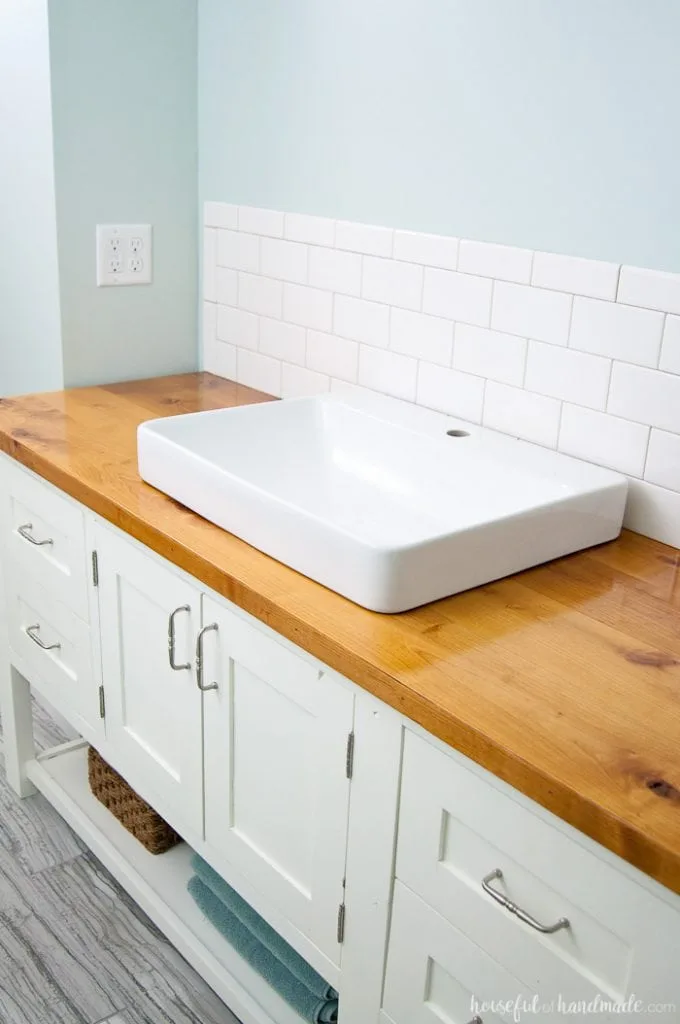
The cost of a wood countertop for a bathroom vanity can vary widely based on the type of wood, the size of the countertop, and the complexity of the design. While wood countertops can be more expensive than laminate or tile options, their durability, beauty, and ability to be refinished can make them a worthwhile investment.
Finally, consider the overall style and theme of your bathroom when selecting a wood countertop. Whether you’re aiming for a spa-like retreat, a cozy rustic space, or a sleek modern design, a wood countertop can be tailored to fit your vision. The natural warmth and beauty of wood can make your bathroom a more inviting and stylish space.

Common Mistakes to Avoid:
Improper Sealing: Failing to properly seal the wood can lead to water damage, swelling, and warping. Ensure the countertop is thoroughly sealed and resealed as necessary to maintain its protective barrier.
Using Harsh Cleaners: Harsh chemicals and abrasive cleaners can strip the sealant and damage the wood. Stick to mild soaps and water for cleaning, and always dry the surface thoroughly.
Ignoring Maintenance: Regular maintenance, including cleaning and resealing, is crucial for the longevity of a wood countertop. Ignoring these tasks can lead to deterioration and a shorter lifespan for the countertop.
Choosing Soft Woods: Softer woods are more prone to dents and scratches, making them less suitable for high-use areas like bathroom vanities. Opt for harder woods like oak, walnut, or maple for better durability.
Neglecting Design Compatibility: Not considering the overall design and style of your bathroom when choosing a wood countertop can result in a mismatched look. Ensure the wood type, finish, and edge treatment complement your bathroom’s design.

Are wood countertops suitable for bathrooms?
Yes, wood countertops can be suitable for bathrooms if properly sealed and maintained. Hardwoods like oak, walnut, and maple are ideal choices due to their durability. Regular sealing and careful cleaning are essential to protect the wood from moisture and ensure a long-lasting countertop.
How do I maintain a wood countertop in the bathroom?
Maintaining a wood countertop involves regular cleaning with mild soap and water, avoiding harsh chemicals, and ensuring the surface is dry after cleaning. Additionally, reseal the countertop periodically to maintain its protective barrier against moisture. Sanding and refinishing can also restore the countertop’s appearance if it becomes scratched or worn over time.
What types of wood are best for bathroom countertops?
Hardwoods like oak, walnut, and maple are excellent choices for bathroom countertops due to their strength and resistance to dents and scratches. Bamboo is another durable and sustainable option. These woods can withstand the humidity and daily use typical in bathroom environments.
Can I use a vessel sink with a wood countertop?
Yes, vessel sinks are compatible with wood countertops and can add an artistic element to the bathroom. Ensure that the area around the sink is well-sealed to prevent water damage. Vessel sinks sit on top of the countertop, providing an opportunity to showcase the wood’s grain and finish.
How often should I reseal my wood countertop?
The frequency of resealing depends on the type of sealant used and the amount of wear and tear the countertop experiences. Generally, resealing every one to three years is recommended to maintain the wood’s protective barrier. Regularly inspect the countertop for signs of wear and reapply sealant as needed to ensure optimal protection.
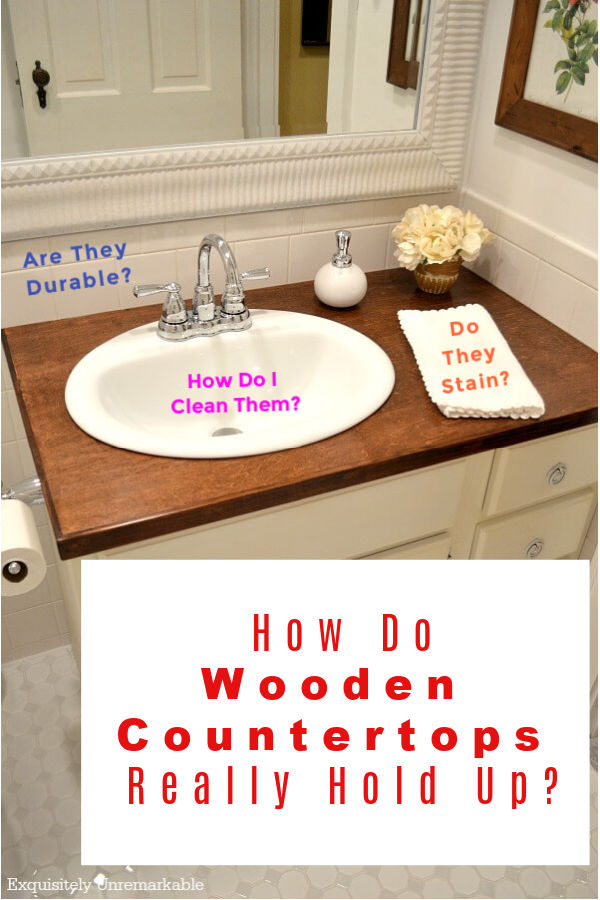
Wood Countertops For Bathroom Vanities

The Foolproof Guide to DIY Wood Countertops for a Bathroom
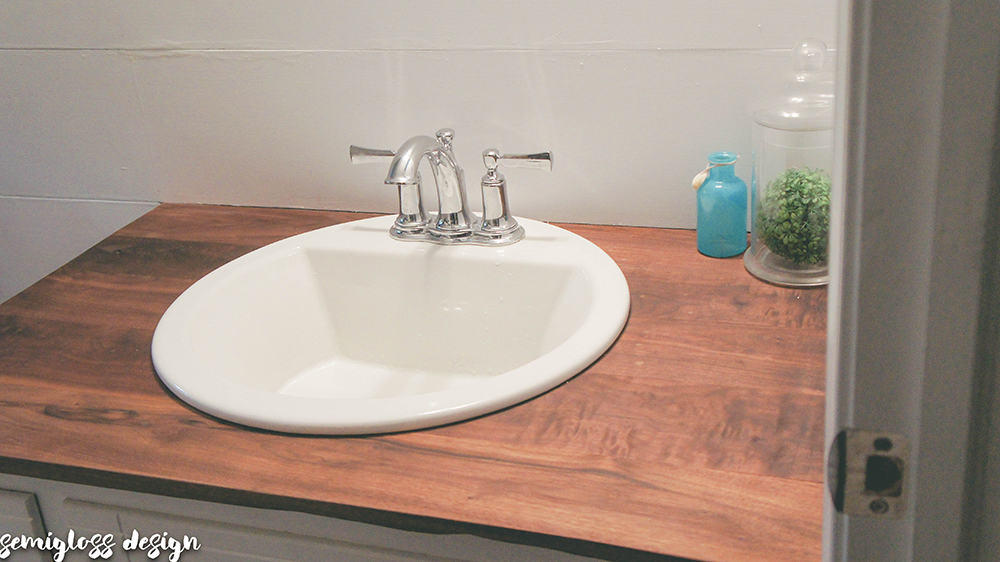
19″ Oval Copper Bath Sink in Wooden Countertop
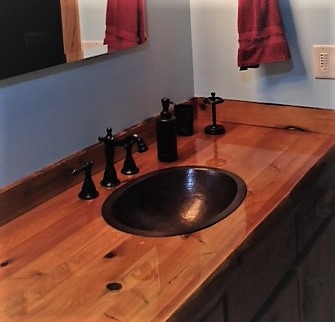
How to Build u0026 Protect a Wood Vanity Top – Houseful of Handmade
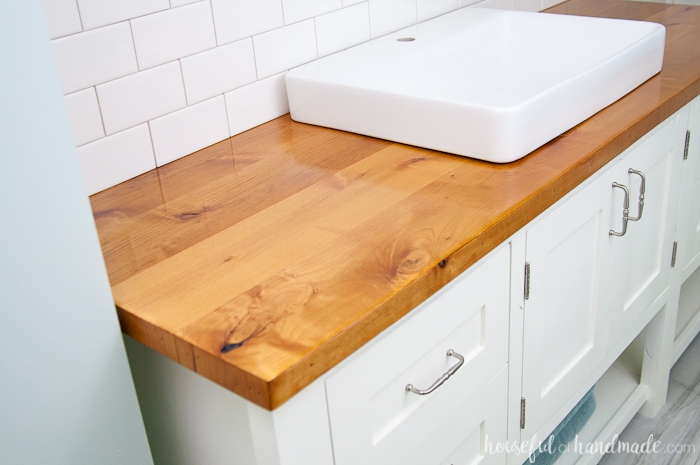
Related articles:
- Replace Bathroom Countertop
- Bathroom Countertop Refinishing
- Is Marble A Good Choice For Bathroom Countertops
- Solid Surface Bathroom Countertop Options
- How To Paint A Bathroom Countertop
- White Granite Bathroom Countertops
- Wood Countertop For Bathroom Vanity
- Rustic Bathroom Countertop Ideas
- Price For Granite Bathroom Countertops
- Bathroom Countertop Covers